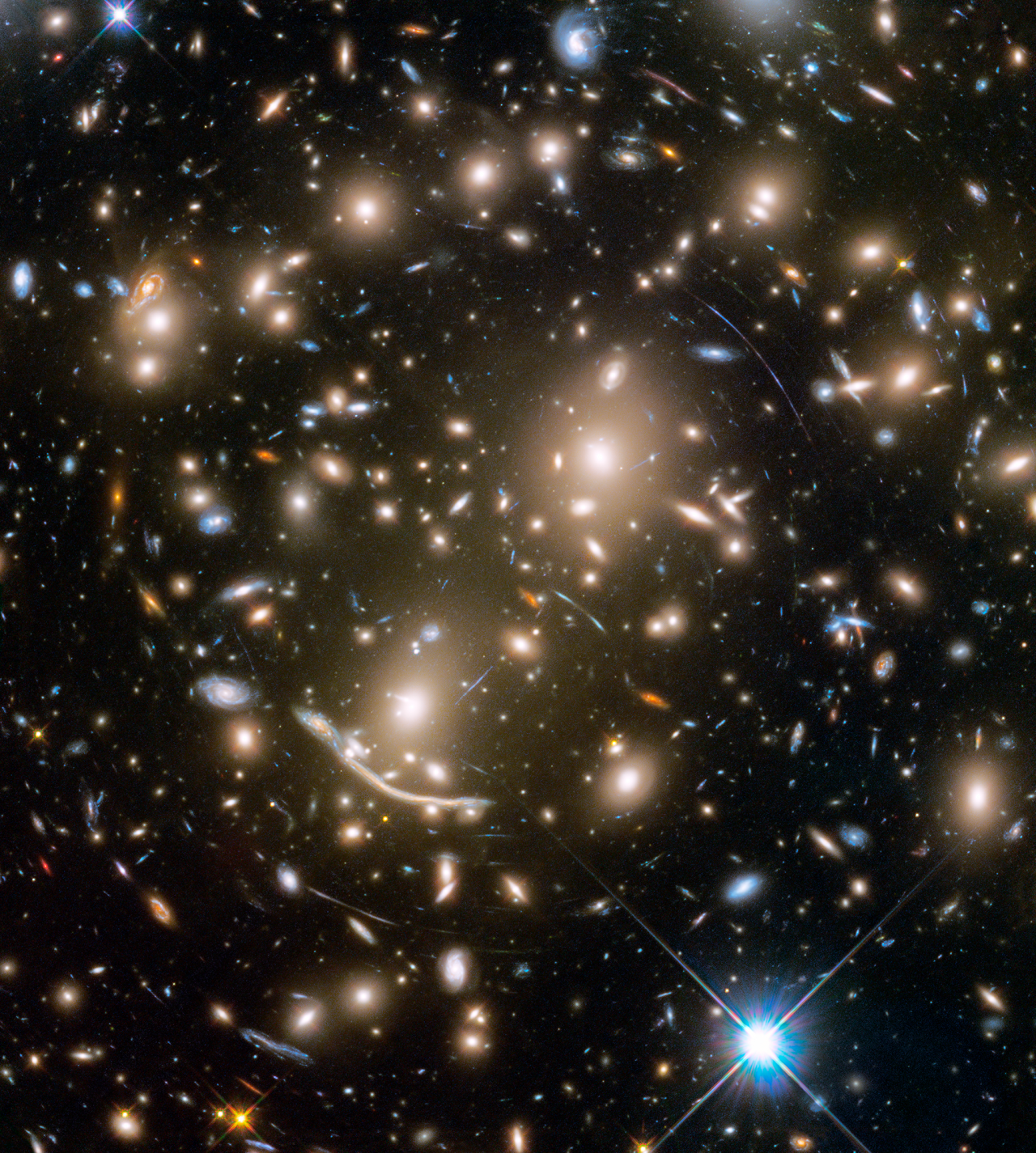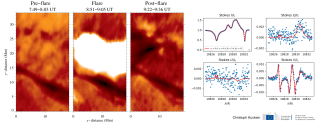Grants related:
General
Galaxies in the universe can be located in different environments, some of them are isolated or in low density regions and they are usually called field galaxies. The others can be located in galaxy associations, going from loose groups to clusters or even superclusters of galaxies. One of the foremost challenges of the modern Astrophysics is to achieve a complete theory about galaxy evolution. This theory should explain the relation between the environment and galaxy evolution. Galaxy clusters are high density environments where galaxies interact one to each other and with the intracluster material (ICM). In addition, the cluster dynamics is driven by the high density and quantity of dark matter present in them. Therefore, galaxy clusters are complex systems with multiple components (galaxies, ICM, dark matter) which are tightly bounded. The mix of all these components, as well as their interactions, makes galaxy clusters ideal laboratories to study the different mechanisms which cause the different evolution of galaxies in this high density environments with respect to field galaxies.
The objective of this project is to study the formation and evolution of galaxies in these dense environments. The ‘Galaxy Evolution in Clusters’ group intend to understand in what environment each of the mechanisms proposed by numerical simulations to transform the galaxies dominates and how the evolution of the different types of galaxies (both bright and dwarf) occurs in the clusters. Quantifying observationally the efficiency of these mechanisms is not an easy task since many of them act at the same time, they do it in very different time scales, and in diverse regions of the cluster. However, there are some observational evidences that can be directly contrasted: i) morphological and structural distribution of the galaxies of the clusters; ii) luminosity function of galaxies in clusters; iii) diffuse light (quantity and distribution); iv) presence of galactic substructures within the clusters; v) spectro-photometric properties of dwarf and bright galaxies; vi) ICM properties. All these observables provide the necessary information to understand the relationship between environment and galactic evolution. These are the quantities this project aims at measuring for large samples of galaxy clusters.
Members
Results
- Intrinsic Shape of Galactic Bars. We find, for the first time, that 52% (16%) of bulges are thicker (flatter) than the surrounding bar. We suggest that these percentages might be representative of the fraction of classical and disc-like bulges in our sample, respectively.
- The Influence of the Environment in the Star Formation Quenching. Our results indicate that in low-density environments, post-starburst galaxies are formed by gas-rich minor mergers or accretions, whereas for high-density environments PSBs would be produced by the removal of the gas reservoirs of emission line galaxies by ram-pressure stripping.
- Morpho-Kinematic Properties of Galactic Bulges. We find that photometric diagnostics to separate different types of bulges (disc-like versus classical) might not be useful for S0 galaxies. Using the morpho-kinematics properties of S0 bulges derived in this paper we suggest that they are mainly formed by dissipational processes happening at high redshift.
Scientific activity
Related publications
-
Fossil group origins. IX. Probing the formation of fossil galaxy groups with stellar population gradients of their central galaxies
Context. Fossil groups (FGs) are galaxy aggregates with an extended and luminous X-ray halo, which are dominated by a very massive early-type galaxy and lack of L∗ objects. FGs are indeed characterized by a large magnitude gap between their central and surrounding galaxies. This is explained by either speculating that FGs are failed groups that
Corsini, E. M. et al.Advertised on:
102018 -
Reviewing the frequency and central depletion of ultra-diffuse galaxies in galaxy clusters from the KIWICS survey
The number of ultra-diffuse galaxies (UDGs) in clusters is of significant importance to constrain models of their formation and evolution. Furthermore, their distribution inside clusters may tell us something about their interactions with their environments. In this work, we revisit the abundance of UDGs in a more consistent way than in previous
Mancera Piña, Pavel E. et al.Advertised on:
122018 -
Characterization of a subsample of the Planck SZ source cluster catalogues using optical SDSS DR12 data
Aims: The Planck catalogues of Sunyaev -Zeldovich (SZ) sources, PSZ1 and PSZ2, are the largest catalogues of galaxy clusters selected through their SZ signature in the full sky. In 2013, we started a long-term observational programme at Canary Island observatories with the aim of validating ˜500 unconfirmed SZ sources. In this work we present
Streblyanska, A. et al.Advertised on:
92018 -
On the observational diagnostics to separate classical and disk-like bulges
Flattened bulges with disk-like properties are considered to be the end product of secular evolution processes at work in the inner regions of galaxies. On the contrary, classical bulges are characterized by rounder shapes and thought to be similar to low-luminosity elliptical galaxies. We aim at testing the variety of observational diagnostics
Costantin, L. et al.Advertised on:
122018 -
Gravitational lensing detection of an extremely dense environment around a galaxy cluster
Galaxy clusters form at the highest-density nodes of the cosmic web1,2. The clustering of dark matter halos hosting these galaxy clusters is enhanced relative to the general mass distribution, with the matter density beyond the virial region being strongly correlated to the halo mass (halo bias)3. Halo properties other than mass can further enhance
Sereno, M. et al.Advertised on:
72018 -
Optical validation and characterization of Planck PSZ1 sources at the Canary Islands observatories. I. First year of ITP13 observations
We have identified new clusters and characterized previously unknown Planck Sunyaev-Zeldovich (SZ) sources from the first Planck catalogue of SZ sources (PSZ1). The results presented here correspond to an optical follow-up observational programme developed during approximately one year (2014) at Roque de los Muchachos Observatory, using the 2.5 m
Barrena, R. et al.Advertised on:
82018 -
The VANDELS ESO public spectroscopic survey: Observations and first data release
This paper describes the observations and the first data release (DR1) of the ESO public spectroscopic survey "VANDELS, a deep VIMOS survey of the CANDELS CDFS and UDS fields". The main targets of VANDELS are star-forming galaxies at redshift 2.4 < z < 5.5, an epoch when the Universe had not yet reached 20% of its current age, and massive passive
Pentericci, L. et al.Advertised on:
92018 -
Multi-object spectroscopy of CL1821+643: a dynamically relaxed cluster with a giant radio halo?
We present the study of the dynamical status of the galaxy cluster CL1821+643, a rare and intriguing cool-core cluster hosting a giant radio halo. We base our analysis on new spectroscopic data for 129 galaxies acquired at the Italian Telescopio Nazionale Galileo. We also use spectroscopic data available from the literature and photometric data
Boschin, W. et al.Advertised on:
102018 -
The intrinsic three-dimensional shape of galactic bars
We present the first statistical study on the intrinsic three-dimensional (3D) shape of a sample of 83 galactic bars extracted from the CALIFA survey. We use the galaXYZ code to derive the bar intrinsic shape with a statistical approach. The method uses only the geometric information (ellipticities and position angles) of bars and discs obtained
Méndez-Abreu, J. et al.Advertised on:
92018 -
Observations of a nearby filament of galaxy clusters with the Sardinia Radio Telescope
We report the detection of diffuse radio emission which might be connected to a large-scale filament of the cosmic web covering a 8° × 8° area in the sky, likely associated with a z ≈ 0.1 overdensity traced by nine massive galaxy clusters. In this work, we present radio observations of this region taken with the Sardinia Radio Telescope. Two of the
Vacca, V. et al.Advertised on:
92018 -
Bayesian bulge-disc decomposition of galaxy images
We introduce PHI, a fully Bayesian Markov chain Monte Carlo algorithm designed for the structural decomposition of galaxy images. PHI uses a triple layer approach to effectively and efficiently explore the complex parameter space. Combining this with the use of priors to prevent non-physical models, PHI offers a number of significant advantages for
Argyle, J. J. et al.Advertised on:
92018 -
High redshift galaxies in the ALHAMBRA survey. II. Strengthening the evidence of bright-end excess in UV luminosity functions at 2.5 ≤ z≤ 4.5 by PDF analysis
Context. Knowing the exact shape of the ultraviolet (UV) luminosity function (LF) of high-redshift galaxies is important to understand the star formation history of the early Universe. However, the uncertainties, especially at the faint and bright ends of the LFs, remain significant. Aims: In this paper, we study the UV LF of redshift z = 2.5 - 4.5
Viironen, K. et al.Advertised on:
72018 -
The VANDELS ESO public spectroscopic survey
VANDELS is a uniquely deep spectroscopic survey of high-redshift galaxies with the VIMOS spectrograph on ESO's Very Large Telescope (VLT). The survey has obtained ultradeep optical (0.48
McLure, R. J. et al.Advertised on:
92018 -
Serendipitous discovery of a strong-lensed galaxy in integral field spectroscopy from MUSE
2MASX J04035024-0239275 is a bright red elliptical galaxy at redshift 0.0661 that presents two extended sources at 2″ to the north-east and 1″ to the south-west. The sizes and surface brightnesses of the two blue sources are consistent with a gravitationally-lensed background galaxy. In this paper, we present Multi-Unit Spectroscopic Explorer (MUSE
Galbany, L. et al.Advertised on:
92018 -
Morphology and kinematics of orbital components in CALIFA galaxies across the Hubble sequence
Based on the stellar orbit distribution derived from orbit-superposition Schwarzschild models, we decompose each of 250 representative present-day galaxies into four orbital components: cold with strong rotation, warm with weak rotation, hot with dominant random motion, and counter-rotating (CR). We rebuild the surface brightness (Σ) of each
Zhu, L. et al.Advertised on:
92018 -
The origins of post-starburst galaxies at z < 0.05
Post-starburst galaxies can be identified via the presence of prominent Hydrogen Balmer absorption lines in their spectra. We present a comprehensive study of the origin of strong Balmer lines in a volume-limited sample of 189 galaxies with 0.01 < z < 0.05, log (M_{\star }/M_{⊙})>9.5 and projected axial ratio b/a > 0.32. We explore their structural
Pawlik, M. M. et al.Advertised on:
62018 -
Deep spectroscopy of nearby galaxy clusters - IV. The quench of the star formation in galaxies in the infall region of Abell 85
Our aim is to understand the role of the environment in the quenching of star formation of galaxies located in the infall cluster region of Abell 85 (A85). This is achieved by studying the post-starburst galaxy population as tracer of recent quenching. By measuring the equivalent width (EW) of the [O II] and Hδ spectral lines, we classify the
Aguerri, J. A. L. et al.Advertised on:
62018 -
The intrinsic shape of bulges in the CALIFA survey
Context. The intrinsic shape of galactic bulges in nearby galaxies provides crucial information to separate bulge types. Aims: We aim to derive accurate constraints to the intrinsic shape of bulges to provide new clues on their formation mechanisms and set new limitations for future simulations. Methods: We retrieved the intrinsic shape of a sample
Costantin, L. et al.Advertised on:
22018 -
Revisiting the stellar velocity ellipsoid-Hubble-type relation: observations versus simulations
The stellar velocity ellipsoid (SVE) in galaxies can provide important information on the processes that participate in the dynamical heating of their disc components (e.g. giant molecular clouds, mergers, spiral density waves, and bars). Earlier findings suggested a strong relation between the shape of the disc SVE and Hubble type, with later-type
Pinna, F. et al.Advertised on:
42018 -
Fossil group origins. VIII. RX J075243.6+455653 a transitionary fossil group
Context. It is thought that fossil systems are relics of structure formation in the primitive Universe. They are galaxy aggregations that have assembled their mass at high redshift with few or no subsequent accretion. Observationally these systems are selected by large magnitude gaps between their 1st and 2nd ranked galaxies (Δm12). Nevertheless
Aguerri, J. A. L. et al.Advertised on:
12018



